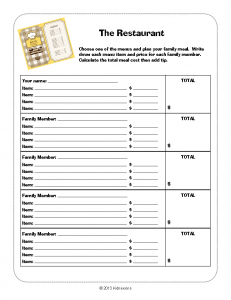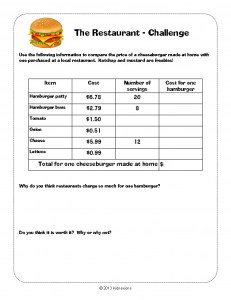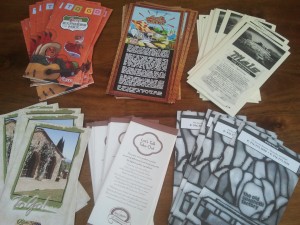The Restaurant: Practicing Arithmetic in Third and Fourth Grade

Here’s a fun activity I do with 4th graders but it can be adapted for third graders. I wouldn’t have the 3rd graders figure out the tip unless you want to offer the high achievers a challenge. It’s also a little difficult for 4th graders but I find it’s a teachable moment, so I help them figure it out using number sense (10% + 5%). If you like, you can simply skip the tip part.
In advance: Collect real restaurant menus. That’s what makes this lesson so much fun. You’re using real menus from real restaurants. But collect the take-out menus because they’re free! I have about 6-8 menu choices of places I know kids like to eat.
Tell the students that their family will be “going out to eat” today. There is space on the worksheet for five family members including themselves. If they have more than that, tell them that the other members had someplace else to be. If they have less than 5 they can include grandma, grandpa, etc.
Show them how to fill in the worksheet. In the left column, tell them to write the names in small lettering. Underneath that they will be writing each of the items the family member orders. Of course, they will be ordering for all members. This gets to be fun as they will usually find the most “disgusting” thing on the menu for their siblings.
Also, no alcohol, even if mom or dad usually orders it. Let’s not create any problems!
In the right column, they can add the prices of the item ordered and write the total next to the ‘$’ sign. Each family member total gets tallied and the final amount gets written next to TOTAL MEAL COST. They’re going to get a lot of practice adding columns of numbers.
If you don’t show kids how to neatly write all this down (maybe have a sample one ready), they write large and all over the place. It makes it hard to stay organized.
Since not all menus have drinks listed, I write on the board:
soda (free refills) $2.50
milk $2.60
iced tea/lemonade $2.50
When it comes time to pass out the menus, line the menus up on a long table and have groups of 4-5 kids pick out their menu. You can also read all the restaurants and then have kids raise their hand for a given restaurant and pass them out that way.
As students start working, you’ll spend a lot of time walking around the room making sure they stay on track and fill out the worksheets correctly. I would put on a timer and remind them how much time they have left because time goes pretty quickly.
You’ll need to stay on top of the voice level. Kids LOVE this activity and they tend to get pretty excited.
Challenge:

For those who need an extra challenge, they can compare a hamburger bought in a restaurant with one made at home. This part is going to require they do division so I would have them work together and problem solve. I let them round the prices to make it easier. For example, they can round $5.99 to $6. They’ll also need to figure out and agree on the approximate number of slices they can get out of a tomato and onion. The prices I used came from safeway.com back in 2011. Feel free to update!
Using an example hamburger from one of the menu restaurants, have them compare the prices of the restaurant burger and the homemade hamburgers. It’s usually an eye-opening experience. Kids will discover that when your parents take you out to eat, it’s a lot more expensive than cooking at home. You’re paying for the ambiance, waiters, cooks, electricity, etc.
